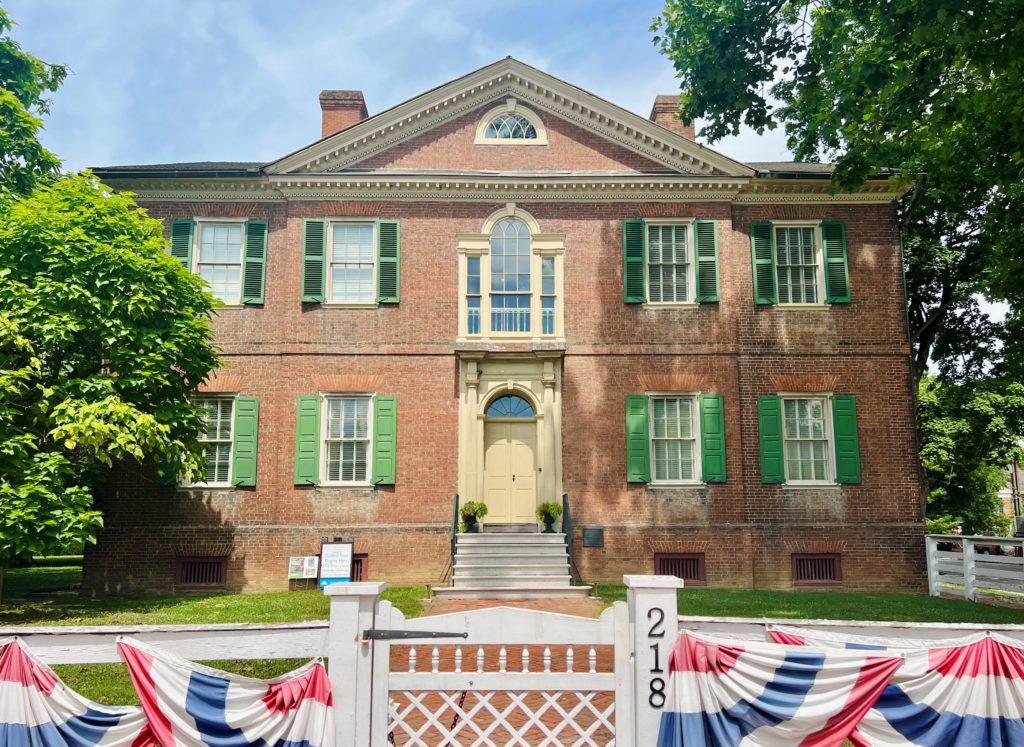We learned in Part 1 of this article that Liberty Hall, the National Historic Site, on the corner of Wapping and Wilkinson Streets, is one of the most hallowed houses in America, dating to 1796.
We learned that its owner John Brown, lawyer, politician and social leader, was one of the most influential men of his day, hosting everyone from past and future presidents to French nobility.
And we learned that the furnishings of the house are the originals purchased by Brown and his wife Margaretta. Anyone who has ever visited a historic home knows how rare it is to find original furnishings rather than reproductions.
This part of the story will focus on the efforts of Liberty Hall’s executive director Jessica Stavros and her Board of Directors to not only keep this Kentucky and national treasure alive, but to help it thrive.
The new motto for Stavros and her staff is Founding Forward, which connects the house to the founding of Kentucky and the nation and its glorious past, and to looking forward to continued opportunities and community involvement.
Four Main Interpretive Themes
Stavros says the current approach to lure visitors is to base their efforts on four major themes.
“First is the story of the indigenous people and the land,” says Stavros.
Where Liberty Hall’s gardens – in the spring gloriously blanketed with bluebells and daffodils – slope down to the Kentucky River, was once the spot where Cherokee and Shawnee crossed the river at its lowest point, a spot known as Devil’s Hollow.
The second interpretation involves the concept of “urban enslavement,” one that was very different from the plantation variety most closely associated with slave-holding families.
“Many of the slaves at Liberty Hall didn’t even live on the property,” says Stavros, who added that they often had their own dwellings close to, but not on, Liberty Hall grounds.
“It’s interesting to note that just like generations of the Brown family occupied Liberty Hall and the Orlando Brown House located on the property, there were also three generations of one enslaved family (the Stepneys) that lived here,” she says.
The generations of one family that lived here is the third thematic approach, and it covers the family from John Brown down to Margaret Wise Brown, renowned author of children’s books Goodnight Moon and Runaway Bunny.
The fourth is on John Brown’s political connections and contributions and his civic involvement at local, state and national levels, which we saw in Part 1.
Visitors can learn about each of these four themes during tours of the house. However, the one tour that captivates both adults and children is the story of the Gray Lady ghost (and yes, there is one designed especially for children.)
Parents needn’t worry – this ghost is benevolent – often referred to as the house’s “beloved ghost.” It is that of Margaretta Varick, Margaretta Brown’s much-loved aunt who died while visiting her niece at Liberty Hall in 1817.
It is believed that she died from either a heart attack or an acute attack of indigestion. Today, visitors have sometimes told of seeing a tall woman veiled in gray on a second-floor bedroom.
Since a love of history and preservation often begins in childhood, Liberty Hall offers many opportunities for parents to introduce their children to history in general and that of the Brown family in particular.
One of the most popular offerings is the Story Book Trail where illustrations from a new children’s book are put up in the garden every Wednesday. The children and their parents can then follow page by page along trails of shrubbery and flowers.
“Our Storybook Trail is much loved by both children and their parents,” says Stavros. “We offer a new book every week. For example, in February we will focus on African American History and in March, on Women’s History.
“All of these books are colorful, inspirational and written and illustrated by people within each of the communities they represent,” she continues. “It’s a great way for children to get fresh air and exercise while learning to become lifelong readers.”
Children from the First Presbyterian Church across the street from the house still use the same two benches in the garden for their Sunday School lessons that pioneer children did two centuries ago.
Both adults and children are drawn to the Butterfly Garden and the Mother’s Garden. The latter honors mothers everywhere through plants in a special section of the garden. There is also a beautiful plaque here celebrating the close relationship between Margaretta Brown and her son Orlando.
The garden is the site of Liberty Hall’s annual fundraiser every spring, and for the rest of the year, a place for all to visit, reflect and relish in the beauty of the natural environment.
Whether it’s a ghost tour or a garden yoga class under the apple tree, Liberty Hall has something for everyone.

